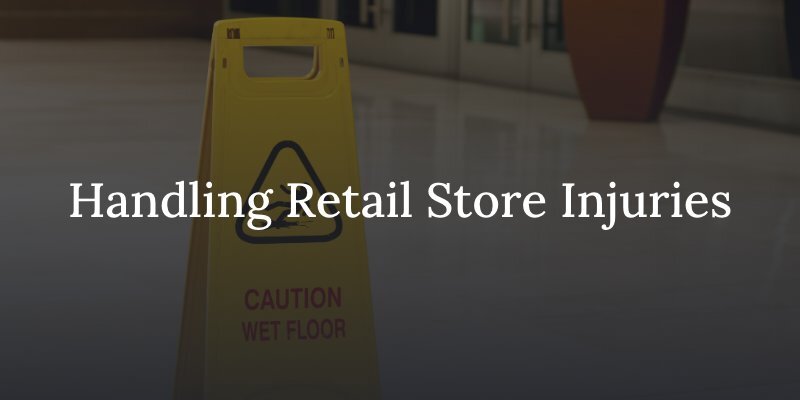No one expects their day out shopping or a quick trip to the grocery store to end in a serious injury, yet thousands of injuries occur in retail stores each year. Store injuries are most common in big box stores during the busy holiday season, but can happen at any time to individuals of all ages.

Suffering an injury in a public place sometimes results in more than just embarrassment. Some injuries can be serious or even life-altering. It’s even more distressing for a victim when the injury occurred through no fault of their own but because of a preventable safety hazard in a retail store. But what should an injury victim do to protect themselves after an injury in a grocery store, department store, or mall?
How Do Injuries Occur in Retail Stores?
Slip-and-fall accidents are by far the most common injuries experienced in stores, restaurants, bars, and cafes. Slippery floors, wet floors, debris or clutter on the floor, loose or curled mats and carpets, or dangling cords, all present significant slip, trip, and fall hazards. Other common causes of retail store injuries are falling shelves, falling products, or falls from heights on stairways and escalators.
Preserve Important Evidence at the Scene
Depending on the severity of your injury, you may be unable to take steps to help yourself, but if you’re able to function and move safely, you or a companion can use a cell phone to quickly document evidence that can help you later. First, use the phone to call 911 if it’s a serious emergency, or to call a friend or loved one to transport you to a hospital or urgent care center. Then, do the following:
- Take photos of the cause of the accident, such as a wet floor or broken handrail
- Photograph any visible injuries
- Add the contact information of any eyewitnesses
- Be sure to time-stamp the photos so they are accurately dated
It’s not uncommon for store managers and owners to quickly hide or correct the cause of a serious injury in their retail business to protect themselves from liability. By taking time-stamped photos, it provides compelling evidence for a claim for damages later.
Ask for an Accident/Incident Report
All major retailers and most smaller businesses keep accident or incident report documents on hand for injuries to workers and customers. Immediately after suffering an injury, report the injury to the store manager and ask them to fill out an incident report. Then, insist that they give you a copy, or take a photo of the original. There have been cases of store owners later changing the information on the report to hide their liability, so having a copy or photo is a sound preventative measure. If the incident was captured on a store surveillance camera, request that the management not delete the footage.
Go Directly From the Store to the Hospital or Urgent Care Center
Sadly, some injury victims delay getting medical treatment because they believe their injuries are minor, only to discover worsening symptoms in the following days. Back injuries, neck injuries, and even brain injuries do not always present symptoms immediately but develop in the hours and days after the trauma due to inflammation and bleeding. By not going straight to a medical provider after the injury, a store owner’s liability insurance company can dispute your compensation claim by alleging that your injury did not happen at the store.
At the hospital, undergo a complete examination and report even minor symptoms so you have a complete medical report. Obtain a copy of the report for evidence and keep copies of all bills, receipts, and expenses related to the injury.
How can a Personal Injury Attorney Help My Case?
Even with direct evidence, insurance companies commonly dispute claims, assign blame to injury victims, and undervalue settlement offers so the compensation doesn’t adequately cover the associated damages like medical care, lost wages, and pain and suffering compensation. Call the Kansas City personal injury lawyers at Miller & Hine Attorneys at Law for a free confidential consultation so we can evaluate the merits of your case and begin strategizing the best way forward for your recovery.

